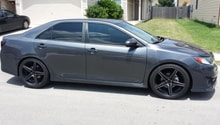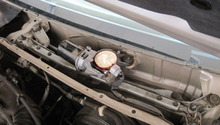Toyota Camry 1997-2001: Coilovers vs. Lowering Springs
Owners wanting to modify their Camry's ride height and handling are left with the decision of which will be better to buy: coilovers or lowering springs. Although lowering springs are effective at achieving a lowered ride height, they are not the best option for the performance oriented racer. Coilovers offer adjustability and when combined with the right knowledge, can create very large improvements in handling.
This article applies to the 4th generation Toyota Camry (1997-2001).
The top race teams in the world rely on coilovers to improve lap times, while lowering springs are installed by millions of drivers across the world for an easy way to improve handling and achieve their desired ride height. So which one is better? This is a question that must be answered by the owner because it depends on your goals for the car.
Companies such as Tein and Ground Control offer coilovers and are reputable in many markets. D2 Racing and MOOG, among others, make commonly used lowering springs. Choosing a coilover or lowering spring from a company with proven results is important because slight engineering miscalculations can create unwanted effects to your Camry's handling. Springs as well as shocks are constantly being compressed and retracted, making the choice of buying a kit with high quality components smart in terms of reliability and safety.
Component Breakdown
Coilovers
Coilovers combine a shock with a spring and many systems are made adjustable. Adjustments include ride height, rebound, and compression. Some kits also include camber adjustability when pillowball mounts, or camber/caster plates, are included. Coilovers from reputable brands offer the buyer a spring that's designed to work in the shocks' operating range. This increases performance without creating poor ride quality.

Lowering Springs
Lowering springs decrease ride height by shortening the length of the spring. They can be purchased with different spring rates by changing the thickness and number of spring windings. Depending on the valving of your shock, a lowering spring may create poor ride quality by making the shock work outside of its operating range. This is most commonly seen with factory shocks, and the effects include bounciness over bumps as well as noise created when shocks move to their maximum length of travel. Unlike coilovers, springs have no adjustment; what you get is what you get.

Common Questions
Are coilovers worth the extra cost over lowering springs?
This depends on what you choose to use the car for. Road course and auto cross racers will benefit most from the adjustability that coilovers offer. Owners looking for improved visual appeal and better handling over stock will benefit from lowering springs the most.
Which one is harder to install?
Lowering springs are harder to install. The factory spring must be compressed before it can be removed from the shock. The new spring must be compressed during installation. This can be dangerous and the proper tools must be used. Coilovers are usually pre-assembled and are more of a bolt-in and go process.

How will changing the ride height of my vehicle affect my alignment/tire wear?
Lowering your vehicle will change your camber settings. This is the angle that determines how much of your tire contacts the road. Some coilovers include adjustable top mounts or camber plates, eliminating the need for a camber kit. An alignment is required after installation, or changes in ride height.
What is shock rebound and compression (bump)?
Shock rebound is the force at which the shock opens against the springs, expanding movement. Rebound has a large effect on how well the tires maintain contact with the road surface. Shock compression refers to the amount of force required for the shock to begin absorbing impacts. Compression has similar effects as rebound because both work together unanimously for handling performance. When one or both are not set properly, the driver may notice a bounciness throughout the car or poor traction with the road surface.
This video below, from QA1 Precision Products, shows how a performance shock is adjusted to fine tune its valving.
Featured Video: How Performance Shocks Are Tuned
Can I have my own custom spring rates made?
Yes, springs can be designed to any rating you choose. This is very useful for owners with added weight such as audio systems. A stiffer spring in the rear will reduce the sagging and maintain the cars handling more effectively. Eibach and Swift are two of the more popular companies offering springs with custom rates.
Can I combine my own choice of shocks and springs?
You can, but make sure both are designed to work together; otherwise, you'll have the unwanted effects that some users, with factory shocks and lowering springs, have. Combining a high quality adjustable shock such as a Koni with a high quality spring is a good way to save money and create a setup with unique handling performance.
Related Discussions
- Coilover Kit vs. Lowering Springs - CamryForums.com
- Lowering My Car - CamryForums.com
- K-Sport Coilovers - CamryForums.com






